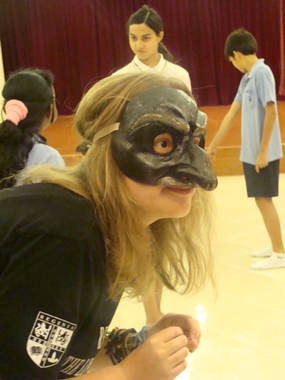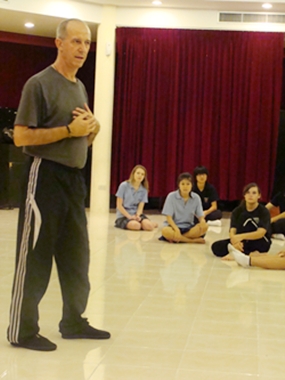Commedia dell’Arte, “comedy of craft”, is a form of theatre originating in Italy in the 16th century, consisting of performances based on the improvisation of sketches or scenarios where the actor wears a mask and performs a scene. The characters of the commedia usually represent stereotypical characters such as servants, masters and lovers.
In early February, Marco Lully, an actor, director and theatre teacher, visited the Regent’s School in order to present a workshop on Commedia dell’Arte. He taught year 10 and 11 drama GCSE groups as well as ten students from the International School of the Eastern Seaboard (ISE) the basic techniques needed to perform physical theatre in the Commedia style.
 Showing emotions through movement.
Showing emotions through movement.
Marco Lully stated that in order to portray a character, we must become the character. We do this by changing our physicality. Each person will have a different offstage posture. However, once onstage we must alter this in order to become a different character. We can do this by changing the way we walk, by using a different leading point in our body as well as the pace, and the status of the character.
During the workshop, Marco Lully teaches us how to stand neutrally by balancing our weight between our left and right leg. By adopting the neutral standing position, we are able to shift our weight across our body to walk in a particular way.
Commedia dell’Arte employs masks, but this does not necessarily mean that just wearing a mask makes the actor automatically become a different character. Mr Lully demonstrated this to the group by teaching us the stereotypical stances of a servant and a master.
For a master, the character walks slowly with big strides and poise with their chin up and their chest out, whereas for a servant, the posture would be more withdrawn. They would take smaller steps and scamper after their master while bowing their heads and hunching their backs.
 Mr. Lully shares his expertise with drama students.
Mr. Lully shares his expertise with drama students.
In Commedia dell’Arte, it is important to make sure the audience understands what is happening in the scene. Mr Lully showed this through the use of exaggeration and miming. Gibberish is also used, because speech is less meaningful than movement.
Through exaggerated movements, the audience can clearly fathom what the actor is trying to portray in the scene. Commedia’ dell’ Arte relies on the audience reaction; it is comedic physical theatre in which the actor interacts with the audience.
These were some of the things we learnt in the Mr Lully’s fascinating workshop.
We also learnt about the masks used in commedia dell’arte, which are mostly half-masks with a neutral expression, so the actor has to portray the feelings of the characters themselves though their physicality and facial expressions such as mockery, sadness, gaiety, confusion and so forth. Everyone in the workshop had a go at becoming a servant or a master and wearing the masks, allowing us to explore the differences between these two roles.
The workshop was very educational, but it was also a lot of fun!




